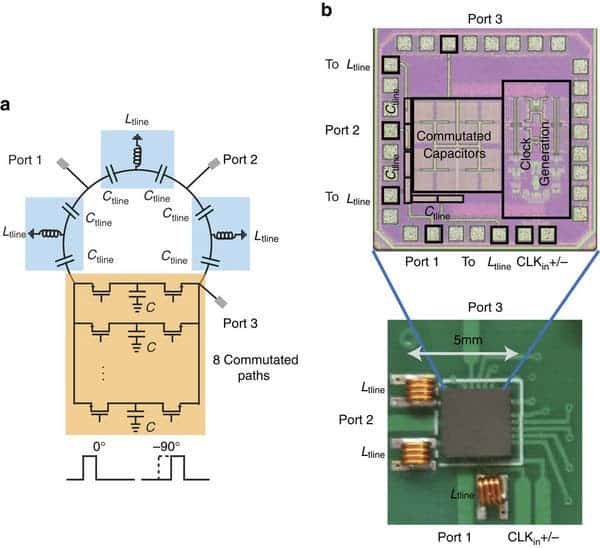A new circuit was demonstrated at the 2016 IEEE International Solid- State Circuits Conference this past February that can, among other things, double Wi-Fi speed, while halving the size of the chip. The researchers at Columbia Engineering invented a new technology they call “full-duplex radio integrated circuits” which uses only one antenna to simultaneously transmit and receive at the same wireless radio frequency.

This is the first CMOS full duplex receiver IC with integrated magnetic-free circulator. Credit: Negar Reiskarimian, Columbia Engineering
“This technology could revolutionize the field of telecommunications,” says Krishnaswamy, director of the Columbia High-Speed and Mm-wave IC (CoSMIC) Lab. “Our circulator is the first to be put on a silicon chip, and we get literally orders of magnitude better performance than prior work. Full-duplex communications, where the transmitter and the receiver operate at the same time and at the same frequency, has become a critical research area and now we’ve shown that WiFi capacity can be doubled on a nanoscale silicon chip with a single antenna. This has enormous implications for devices like smartphones and tablets.”
Key to full-duplex communications which virtually double the useful bandwidth in wireless communications is the circulator. This device transmits the signal entering a port to the next port in rotation. For instance, a three-port circulator where the three ports are “transmit” (1), “receive” (2) and “antenna” (3) works by routing (1) to (3), and (3) to (2). This way, you don’t get (1) to (2) which would’ve meant hearing yourself in a closed loop.
For more than 60 years, these sort of circulators have been used by the industry to provide two-way communications on the same frequency channel, but they are not widely adopted because of the large size, weight and cost associated with using magnets and magnetic materials. These magnets are essential to a working circulator because they “break” Lorentz Reciprocity — a physical constraint of most electronic structures that forces electromagnetic waves to travel in the same manner in forward and reverse directions.

(a) A simplified circuit diagram of the circulator is shown. Electronic commutation across a bank of N=8 capacitors is performed using reciprocal, passive transistor-based switches without direct-current bias. The staggered commutated network enables miniaturization of the unmodulated 3λ/4 ring using three C-L-C sections. (b) The microphotograph of the fabricated IC is shown along with a close-up photograph of the fabricated printed circuit board with the IC housed in a quad-flat no-leads (QFN) package and interfaced with the off-chip inductors. The largest dimension of the prototype is 5 mm or λ/80 at the operating frequency of 750 MHz. Credit: Nature Communications
Electrical Engineering Associate Professor Harish Krishnaswam and colleagues made a breakthrough by scrapping the magnets and using a mini-circulator that rotates the signal across a set of capacitors. They then devised a working prototype of a full-duplex system on a nanoscale silicon chip.
“Being able to put the circulator on the same chip as the rest of the radio has the potential to significantly reduce the size of the system, enhance its performance, and introduce new functionalities critical to full duplex,” says PhD student Jin Zhou, who integrated the circulator with the full-duplex receiver that featured additional echo cancellation.
There’s a myriad of potential applications, from better radar, to faster WiFi, to isolator that prevent high-power transmitters from being damaged by back-reflections from the antenna. Anything that uses half-duplex functions, or virtually all cell phones and WiFi routers, could double performance.
“What really excites me about this research is that we were able to make a contribution at a theoretically fundamental level, which led to the publication in Nature Communications, and also able to demonstrate a practical RF circulator integrated with a full-duplex receiver that exhibited a factor of nearly a billion in echo cancellation, making it the first practical full-duplex receiver chip and which led to the publication in the 2016 IEEE ISSCC,” Krishnaswamy adds. “It is rare for a single piece of research, or even a research group, to bridge fundamental theoretical contributions with implementations of practical relevance. It is extremely rewarding to supervise graduate students who were able to do that!”
Findings appeared in Nature Communications.









